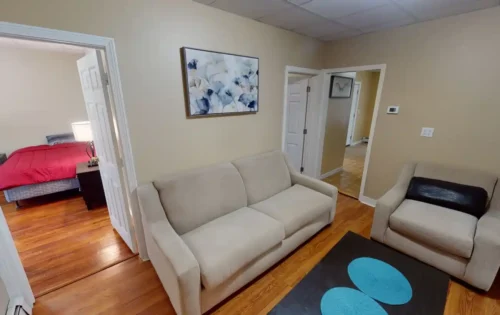
Another significant difference is the length of stay, as sober living homes don’t specify a time limit for residence, with some people staying for as much as five years. This is because, unlike government-funded housing, sober living home residents pay specific fees to stay there. When attending a sober living Pennsylvania program, you will encounter many triggers that might plunge you back into substance abuse. But when you are staying at a sober living home, you will always have someone to help you out.
Nextep Recovery Services
Living in a sober living home for a period of time (usually a few months) provides a chance to figure out all the intricacies that a normal life entails. Complete independence can be a difficult thing to achieve after undergoing treatment in one of the heroin rehab Pennsylvania centers, for example, due to numerous temptations that might be all around you. A sober living house, on the other hand, is void of those temptations altogether. You will be able to focus on your recovery and not worry about getting in contact with any harmful substance. Halfway House staff helps recovering addicts and former inmates reintegrate into society while living in a controlled environment.
Understanding Alcohol’s Toll on Mental Wellness
These platforms facilitate a variety of group activities, including therapy sessions, 12-step meetings, and wellness workshops, all hosted online. Such accessibility ensures that residents can maintain continuous engagement with their support networks, even when attending in-person sessions is not feasible. This virtual connection is vital, enabling continuous engagement and support critical for long-term recovery. In every sober living home, the house manager plays a critical role in maintaining a safe and supportive environment. These individuals are often experienced in dealing with recovery, substance abuse issues, and the dynamics of communal living.
- Mike is highly organized, and plays an integral role in helping families and their loved ones navigate the admissions process.
- No, most insurance plans do not cover the cost of a halfway house because it is considered transitional housing rather than medical treatment.
- In California, the emphasis on holistic recovery approaches is evident, with many homes integrating yoga, meditation, and other wellness practices into their programs.
- This residential facilities offer a supportive, structured environment to help individuals smoothly transition from intensive rehab to independent living.
- You may also succumb to temptations, experience mood swings, and many other difficulties.
Halfway House Requirements for Residents
Halfway houses, also known as residential reentry centers or transitional centers, can provide the support services you need to make a successful transition. These short-term residential facilities offer a supervised and structured living environment for individuals with a history of substance abuse or criminal behavior. People stay in halfway houses from 30 days to 12 months, depending on individual needs, program requirements, and reintegration progress. Residents are required to seek and maintain employment as part of their structured living program. Employment helps individuals develop self-sufficiency, financial stability, and a sense of purpose during reintegration. A Substance Abuse and Mental Health Services Administration (SAMHSA) report found that halfway house residents with stable jobs remain sober for at least one year post-treatment.
Sober living Pennsylvania – A necessary step to full recovery

We may be paid a fee for marketing or advertising by organizations that can assist with treating people amphetamine addiction treatment with substance use disorders. If you or anyone you know is undergoing a severe health crisis, call a doctor or 911 immediately. I packed my bags, loaded them into one of the infamous white rehab vans, and was transported to an office in north Austin. There I was greeted with smiles and open arms, the staff asked me how I was doing and I remember feeling nervous. I was soon transported to the sober house that I would be calling home for the next nine months. For instance, we have seven different room options for residents at our men’s sober living apartment complex in Austin.
We encourage everyone to reinforce positive lifestyle changes through adventure, support, and peer feedback. Shane’s House, our very own sober living home, is a residence where you can learn what it means to truly grow and become empowered. Shane’s House is located right next to the Little Creek Lodge, offering a seamless transition to sober living from one of our treatment programs. Sober living in a sober living house is the last step before attaining full independence. During your stay, you will get to learn everything you might need to maintain sobriety for the long term. Halfway houses are also an excellent “in-between” living situation for individuals with substance use disorder as they complete addiction treatment but aren’t quite ready to fully reintegrate into the community.
You will be permitted to take all of your personal property and will be provided a set of street clothes, or you may have street clothes sent to your facility within 30 days of your release. But Delaware’s Substance Abuse https://ecosoberhouse.com/ and Mental Health Director Elizabeth Romero says the state is still strategizing how to fund sober living long-term. They bus from that center in Wilmington to the Refuge on weekdays to work with Soliman or other members of his team.
- The challenges of living in a halfway house are adjusting to rules, finding employment, and overcoming social stigma, which can make reintegration difficult.
- Factors influencing the cost include whether the facility is government-funded, the type of services provided (such as therapy and job training), and the duration of stay.
- Additional services like counseling, job assistance, and medical care also impact pricing.

According to the National Institute on Drug Abuse (NIDA), 80% of halfway houses mandate active participation in addiction recovery programs. Applicants need to complete an interview, provide proof of sobriety or recent treatment, and agree to house rules before acceptance. Halfway houses are paid for by a combination of public funding, private sponsorships, and resident contributions, depending on the facility’s structure.
Compliance with house rules, including curfews and behavioral expectations, is essential, as violations can result in warnings, loss of privileges, or eviction. If you are able to be a part of a recovery residence, it will be important to understand what type of environment is present. These calls are offered at no cost to you and with no obligation to enter into treatment. Neither this site nor anyone who answers the call what is a halfway house receives a commission or fee dependent upon which treatment provider a visitor may ultimately choose. Calls to numbers on a specific treatment center listing will be routed to that treatment center.

Why Sooner Is Better: The Power of Early Intervention for Alcohol Use
It’s a supportive community where you can rebuild relationships and focus on sobriety. The types of people who live in halfway houses are recovery patients, ex-offenders, and transitional housing residents seeking structured support before reintegrating into society. In contrast, sober living homes are privately operated, post-rehab support residences that offer more flexibility without strict time limits, allowing individuals in addiction treatment to gradually reintegrate into society. The cost of a halfway house ranges from $500 to $2,500 per month, depending on factors such as location, amenities, and level of care.
